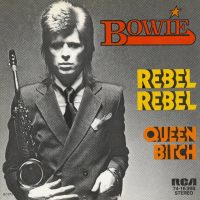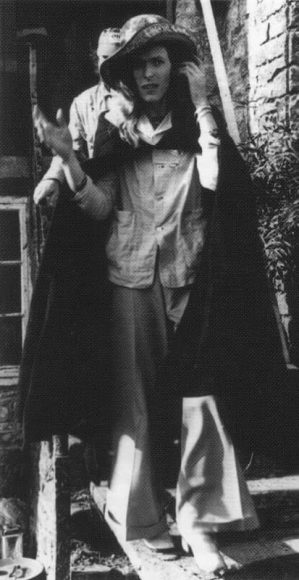 Written by: David Bowie
Written by: David Bowie
Recorded: June–August 1971
Producer: Ken Scott, David Bowie
Released: 17 November 1971
Available on:
Hunky Dory
Bowie At The Beeb
Live Santa Monica ’72
Live Nassau Coliseum ’76
Divine Symmetry
Personnel
David Bowie: vocals, acoustic guitarMick Ronson: electric guitar, vocals
Trevor Bolder: bass guitar
Woody Woodmansey: drums
‘Queen Bitch’, the penultimate track on David Bowie’s fourth album Hunky Dory, was inspired by the American rock band The Velvet Underground.
Some V.U, White Light returned with thanks
Hunky Dory
On 10 November 1966, Bowie’s then-manager Kenneth Pitt, on a trip to New York, visited Andy Warhol at the Factory, his studio on East 47th Street.
He was everything I had expected, looking exactly as he did in the gossip column pictures: the shades, the polo-neck, the mask. I cannot recall what we said or even that we said anything at all. Having been introduced and it have been proved to each other that we existed seemed to be all that was required to set the seal of approval on our plans. In retrospect, I realise that the most significant aspect of my visit to the Factory was my meeting with Lou Reed and being given an acetate advance copy of the Velvet Underground’s forthcoming album. That record was to play an important part in David’s future…On my return from America and Australia I had given David the albums I had brought him from New York, that of the Velvet Underground and a zany group I had heard in Greenwich Village called the Fugs. He adored both of them and particularly liked ‘I’m Waiting For The Man‘ on the former and ‘Dirty Ol’ Man’ on the latter, both of which he used in his act. This was the first time he had heard of Lou Reed and such was his enthusiasm for the American artist that I was more interested than ever in bringing Andy Warhol and the Velvet Underground to Britain. What if they formed a mutual admiration society, with Warhol and the Velvets singing David’s praises in America?
The Pitt Report
Although Bowie was blown away by the sound of the Underground, it took several more years before their influence was heard. Indeed, despite Pitt’s recognition of Bowie as a kindred spirit, there is little of the Velvets in his 1960s music, although he did record an unreleased version of ‘I’m Waiting For The Man’ with The Riot Squad in 1967.
Despite the disparity between Bowie’s public image and his love of American garage rock, he strove to perform the music of the Velvet Underground with his 1967 bands The Buzz and The Riot Squad. In 2003 he recounted the circumstances to Vanity Fair magazine:
[The album was] brought back from New York by a former manager of mine, Ken Pitt. Pitt had done some kind of work as a P.R. man that had brought him into contact with the Factory. Warhol had given him this coverless test pressing (I still have it, no label, just a small sticker with Warhol’s name on it) and said, “You like weird stuff – see what you think of this.” What I “thought of this” was that here was the best band in the world. In December of that year, my band Buzz broke up, but not without my demanding we play ‘I’m Waiting For The Man’ as one of the encore songs at our last gig. Amusingly, not only was I to cover a Velvets song before anyone else in the world, I actually did it before the album came out. Now that’s the essence of Mod.
Vanity Fair, 2003
The Velvets were perhaps the quintessential New York City rock band, but Bowie’s ‘Queen Bitch’ was set in the English capital. In the notes used in press adverts for Hunky Dory he wrote that it was “A song on a Velvet Underground-Lou Reed framework s’about London sometimes.”
Nothing special from my end, just four guys playing and singing their arses off.
Five Years (1969-1973) book
Whereas most of Hunky Dory was expansive, combining Rick Wakeman’s piano with Mick Ronson’s lush orchestration, ‘Queen Bitch’ was a tight rocker, a simple recording with just guitars, bass and drums, and paved the way to the sound of Ziggy Stardust. Indeed, its simplicity and immediacy meant it remained in Bowie’s live set during the Ziggy Stardust Tour (1972-3), Isolar Tour (1976), Sound + Vision (1990), Earthling Tour (1997), and A Reality Tour (2003-4).
A lot has been said about how Hunky Dory was much folkier and very different from Ziggy, but if you take a track like ‘Queen Bitch’, which was on Hunky Dory, that would’ve fit in perfectly with Ziggy, so there wasn’t much of a leap between Hunky Dory and Ziggy, in my estimation.
David Bowie: Ultimate Record Collection (Uncut)
In addition to the VU riffs and swagger, on ‘Queen Bitch’ Bowie adopted slang from the street: cruisers, scoring drugs, “satin and tat” (a phrase of Lindsay Kemp’s to denote theatricality) – only “bipperty-bopperty hat” let the cool mask slip, and was hurriedly followed by Bowie’s cover-note: “Oh God, I could do better than that”.
In 2018 the Bowie Estate suggested that the hat was the one worn by the singer during his 1971 Glastonbury Festival performance.
The package features photos of Bowie resplendently dressed in a 3/4 length one-of-a-kind Alexander McQueen frock coat, the pattern of which was made to echo the hat (the famous ‘bipperty-bopperty hat’ mentioned in the song Queen Bitch) and worn by David at his Glastonbury Fayre debut in 1971.
Funnily enough when we were back in Hull and Ronno was doing an album, we needed a song and David sent ‘Queen Bitch’ up to us. We actually learned it up in Hull. This was before Hunky Dory, so we’d already got that one nailed before we even did Hunky Dory, because we were playing it live anyway.
Kooks, Queen Bitches And Andy Warhol, Ken Sharp
The music owed a debt to the likes of ‘Sweet Jane’, but the guitar riff was purloined from Eddie Cochran’s posthumous single ‘Three Steps To Heaven’.
Even though David may have started the spark for that song inspired by the Velvet Underground, for me it was not that. We didn’t want to play it like the Velvet Underground because there wasn’t a musical finesse there that we considered we had. [laughs] And I love the feel of a lot of the early Velvets stuff, but it didn’t have that Englishness. So there were a few ways of approaching ‘Queen Bitch’. You could do it as an out and out Velvet Underground type of track, or how we did it. It was kind of a dirgey, degraded scene that the song painted, but if we all went that way it would be very dirgey [Laughs] and that wasn’t our thing. So we had to come up with an-other way to approach it and give it a little bit of class and taste. There was always that, let’s not do it the common way. There was a little bit of that viewpoint on things.
Kooks, Queen Bitches And Andy Warhol, Ken Sharp
In February 1974 the single ‘Rebel Rebel’ was released, with ‘Queen Bitch’ on the b-side in numerous countries.
In the US, ‘Queen Bitch’ was the b-side of ‘1984’, released on 5 August 1974.


